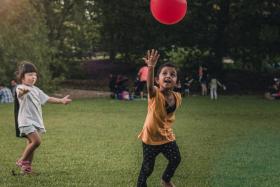Confessions of one of the first female pilots
Mrs Sharon Walker was one of the first female pilots in RSAF
Even as a young girl, Mrs Sharon Walker knew she wanted to be a pilot.
Today, Mrs Walker, 59, is one of Singapore's longest serving female pilots.
She told The New Paper: "Being a pilot was a childhood dream for me. Nothing enthralled me like National Day air shows."
She would watch wide-eyed as the thundering jets tore up the sky, performing death-defying loops and barrel turns.
But in the male-dominated industry, getting into the cockpit proved to be a challenge.
In 1975, aged 16, after completing her O-level examinations, she had applied to be a cadet at the Republic of Singapore Air Force (RSAF). She was rejected as women were not allowed to be pilots then.
Mrs Walker tried again in her second year at Singapore Polytechnic (SP), even writing a letter to then minister for defence, Dr Goh Keng Swee, asking to join the air force.
Six months before graduating from SP, she received an invitation to join the RSAF with another female cadet. They became the first female pilots in the air force.
"I was really happy and excited as I was getting closer to my dream," she said.
At the RSAF, she flew a transport plane, which carried cargo, took up parachutists and performed search-and-locate missions.
But as the first female pilot in the operational squadron, some of Mrs Walker's colleagues wondered if she could handle it.
She said: "They thought I would struggle with handling the aircraft's heavy controls. But I quickly got used to it and it was no problem."
In 1997, when she was 38, she was appointed Singapore Youth Flying Club's first female flying instructor.
Mrs Walker stayed there for about seven years, before joining local regional airline SilkAir in 2004 as a commercial pilot, where she is now a senior first officer.
"I wanted to try flying a different aircraft to challenge myself," she said.
Mrs Walker has clocked more than 9,000 hours of flying time, about 70 to 80 hours a month.
And she has seen more women becoming pilots. "Now, not a day goes by when you won't hear a female pilot's voice over the radio," she said.
She said women in the air force have more options today.
"They can join other squadrons now, like the fighter or helicopter squadrons, not just transport," she said.
"It shows women are just as proficient and capable as men."
She even inspired her son, Mr Peter Walker, 33, to be a pilot.
Mr Walker, a first officer for Singapore Airlines, recalls hanging around Seletar Camp and Seletar Airport when he was younger. His mother would even givehim and his younger sister rides on the plane.
He said: "Because of that, being a pilot was always at the back of my mind, and when I was in university, I decided I wanted to be a pilot."
So what is it like working in the same industry as his mother?
"It is great because we have common topics to talk about. Plus, I can listen to some of her experiences and learn from it. I am really thankful for that."
Secrets of the trade
Do your research
It is crucial to study the realities of being a pilot by visiting various airfields, attending career talks, or speaking to those with experience in the field.
Develop your sense of space
Spatial unawareness can be especially dangerous for pilots, causing uncomfortable flights or even accidents.
Perseverance is key
Pilot training is difficult, with a lot of theory lessons, ground school classes and simulator training, and will require hard work.
Get The New Paper on your phone with the free TNP app. Download from the Apple App Store or Google Play Store now


